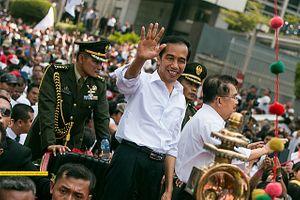Last week, Indonesia held another steel-cutting ceremony for two more of its fast attack crafts. The scheduled event marked another advance for Jakarta in pursuit of its naval modernization in spite of challenges that are expected to continue as President Joko “Jokowi” Widodo embarks on his second term in office.
As I have noted before in these pages and elsewhere, Indonesia has long been engaged in an effort to strengthen the country’s maritime capabilities in recognition of the sobering reality that it needs more vessels and aircraft to fully monitor what is the world’s second longest coastline. That has continued under Jokowi, who just secured a second term in office earlier this year.
One of the classes of vessels that has been in the spotlight in this respect is the guided missile fast attack craft, an effort that has been undertaken with the help of Indonesian companies including state-owned shipbuilder PT PAL. While these have already begun to be produced, Indonesian defense officials have also signaled that Jakarta will need many more such vessels for its future ambitions.
Last month, Indonesia took officially took delivery of its fourth KCR-60M fast attack craft in a commissioning ceremony that was held in Surabaya and attended by top Indonesian defense officials, including Defense Minister Ryamizard Ryacudu.
Last week, this aspect of Indonesia’s naval capabilities was in the headlines with progress on two more fast attack craft. PT PAL held a steel-cutting ceremony for two more KCR-60M fast attack craft that were ordered for the Indonesian Navy (TNI-AL), which together are said to cost around 1.6 trillion Indonesian rupiah ($112 million).
The steel for the vessels was cut at a ceremony on August 2 at PT PAL facilities in Surabaya, which was attended by officials and key personnel. Per local media reports, in remarks at the event, PT PAL director Budiman Saleh noted that the new vessels, which constitute the fifth and sixth within the current class of vessels, were part of a broader effort by Indonesia to continue to improve its platforms over time.
While the fifth and sixth vessels are based on the same general design features of the previous vessels, Saleh said that they would be equipped with more sophisticated technology relative to their predecessors. As of now, existing timelines see the vessels expected to be completed by May 2022 and subsequently delivered to the TNI-AL.

































